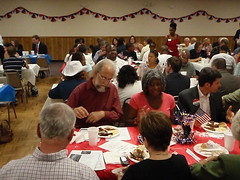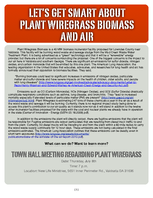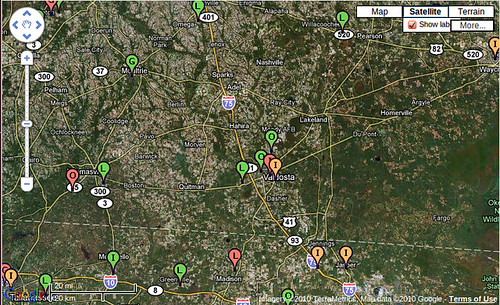Continue readingWhile certain entities see no negative environmental impact of the proposed biomass plant, the information and data that I have does not indicate that incineration of wood is efficient, environmentally sound, or safe for our citizens. Yet others see this as a win-win scenario claiming a vastly different perspective on the situation; economically, environmentally and in regard to the health of our citizens. Why is that?
Category Archives: Forestry
Video of Biomass Air Quality Hearing, Valdosta, 27 April 2010
 A video of
a hearing about the biomass plant Wiregrass Power LLC proposes
to build in Lowndes County just outside of Valdosta was held
in Valdosta on 27 April 2010
by the Air Protection Branch (APD)
of the Environmental Protection Division (EPD) of the Georgia
Department of Natural Resources (DNR).
A video of
a hearing about the biomass plant Wiregrass Power LLC proposes
to build in Lowndes County just outside of Valdosta was held
in Valdosta on 27 April 2010
by the Air Protection Branch (APD)
of the Environmental Protection Division (EPD) of the Georgia
Department of Natural Resources (DNR).
Eric Cornwell of APD explains location, process flow, and specific items covered by the permit (soot, SO2, NOX, CO, VOC, HCL, etc., but not CO2). He remarks that Wiregrass Power LLC is building a small plant with a “lower emission limit in order to avoid some of the red tape” by getting a minor permit instead of a major permit. The first half hour concludes with Bob Turner, the plant manager, presenting similar material, ending with:
“No new carbon is added to the atmosphere when burning woody byproducts.”I beg to differ on that: in the time it takes trees to grow back, there is indeed new carbon dioxide added to the atmosphere. More from Dr. William Sammons on that.
Back to the video of the hearing. Questions start at 00:29:44. Here are some time markers and very brief summaries of Q and A; see the video for the full questions and answers. Continue reading
Where the biomass plants are
Who does know?
We are mapping all of the existing, proposed, closed and defeated dirty energy and waste facilities in the United States. We are building a network of community groups to fight the facilities and the corporations behind them.The detail map shown includes the Wiregrass Power LLC proposed plant (the orange oval I just south of Valdosta), two plants in Hamilton County, Florida Continue reading
Sprawl to ruin, or dense with green space for quality of life
 Jeffrey H. Dorfman,
Professor, Dept. of Agricultural & Applied Economics,
The University of Georgia:
Jeffrey H. Dorfman,
Professor, Dept. of Agricultural & Applied Economics,
The University of Georgia:
Local governments must ensure balanced growth, as sprawling residential growth is a certain ticket to fiscal ruin*See The Economics of Growth, Sprawl and Land Use Decisions.
* Or at least big tax increases.
Note and jobs, not just people: jobs so the people can work and afford the houses they live in.
- Green spaces increase property values of surrounding land
- Green and open spaces can provide environmental amenities for free
- If green spaces contribute to quality of life, you attract people and jobs to community
But this doesn’t mean exurban subdivisions with big yards: Continue reading
Dr. William Sammons on Biomass Sustainability and Economics
 Here’s an interesting
video interview
with Dr. William Sammons,
the doctor who spoke in Traverse City just before that biomass plant was nixed.
Here’s an interesting
video interview
with Dr. William Sammons,
the doctor who spoke in Traverse City just before that biomass plant was nixed.
Is it more important to reach the target … or to say we have new information and we need to revise the targets and what qualifies?He’s talking about potential billions of dollars of health costs from particulates, about “waste” wood (what they say they will burn) vs. whole trees (what they end up burning), and most importantly about sustainability.
Biomass plants don’t have to report their CO2 emissions, so if all the proposed biomass plants get built we’re talking about as much as 800 million tons of CO2 from biomass plants by 2020, 12 to 14% of total CO2 emissions for the U.S. (not just power emissions: total national emissions). Trees don’t grow fast enough to suck all that back out of the air in ten years. Continue reading
Valdosta in bottom 10 metro areas for wages
The Valdosta Metropolitan Statistical Area (MSA) comes in the bottom 10 nationwide. That’s for overall average wages.
It doesn’t look quite as bad for specific classes of jobs (creative, service, and working class), but that’s mostly because there are almost no MSAs in the lowest pay tier. However, for service jobs, Valdosta is not as good as Tallahassee, and makes it into the bottom 10: Continue reading
Candidates, Lowndes County Commission, District 2, at LCDP BBQ
 Every year the Lowndes County Democratic Party (LCDP)
has a barbecue to which it invites candidates for public office.
These include local candidates. Here we have the two Democrats
running for Lowndes County Commission in District 2, in alphabetical order:
Debra M. Franklin
and
John S. Quarterman.
Notice the two candidates dining amicably side by side.
Every year the Lowndes County Democratic Party (LCDP)
has a barbecue to which it invites candidates for public office.
These include local candidates. Here we have the two Democrats
running for Lowndes County Commission in District 2, in alphabetical order:
Debra M. Franklin
and
John S. Quarterman.
Notice the two candidates dining amicably side by side.
Debra M. Franklin: Continue reading
Biomass Town Hall, 8 July 2010
 On July 8th there was a
town Hall meeting about the biomass plant proposed for Valdosta.
On July 8th there was a
town Hall meeting about the biomass plant proposed for Valdosta.
Pastor Angela Manning of New Life Ministries sums up why she called this Town Hall meeting:
Speakers included: Continue reading
Center of Innovation – Energy
“Forests Dominate Georgia’s Land Use”
 That’s the title of slide 10 of 21 in
Center of Innovation – Energy (CIE)
by Jill Stuckey, Director.
Actually, massively pesticided planted pines dominate south Georgia’s land use;
not the same as actual forests with species diversity and diverse ages of trees.
The same CIE slide equates
That’s the title of slide 10 of 21 in
Center of Innovation – Energy (CIE)
by Jill Stuckey, Director.
Actually, massively pesticided planted pines dominate south Georgia’s land use;
not the same as actual forests with species diversity and diverse ages of trees.
The same CIE slide equates
Georgia Forestry = Biomass EnergyThat is what the state government seems to want it to be.
Back on slide 9, solar is defined as a southwestern regional energy source; nevermind that the solar map on that page shows Georgia with the same insolation as most of Texas (more on that later). And wind is defined as a central U.S. regional strength, nevermind that even Georgia Power has started exploring the possibility of wind off the Georgia coast.
I get it that Georgia has trees and forestry is a big industry in Georgia. I’m a tree farmer myself. I’d love to be convinced that biomass from trees is one good way to go. But at what costs? And compared to what? Continue reading
Nix on biomass plant in Traverse City, Michigan

Complaints are more frequent along Mary Street, a short stretch a few hundred yards south of the plant. Residents there deal with more intense noise and odors.Nonetheless he didn’t say it affected his property values. However, that’s not the only issue.Craig Walworth’s home is among the closest to the plant. He walked up to his Jeep — a vehicle he cleaned the day before — and dragged his finger through a layer of film on the hood.
“Every morning, you have that to look forward to,” he said. “I clean my screens three times a year during the summer because they clog up.”
Meanwhile, about an hour north on the edge of Lake Michigan, in Traverse City local activism caused cancellation of a proposed biomass plant: Continue reading

